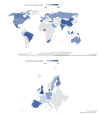Hesitant or Not Hesitant? A Systematic Review on Global COVID-19 Vaccine Acceptance in Different Populations
- PMID: 34452000
- PMCID: PMC8402447
- DOI: 10.3390/vaccines9080873
Hesitant or Not Hesitant? A Systematic Review on Global COVID-19 Vaccine Acceptance in Different Populations
Abstract
Vaccination currently appears to be the only strategy to contain the spread of COVID-19. At the same time, vaccine hesitancy (VH) could limit its efficacy and has, therefore, attracted the attention of Public Health Systems. This systematic review aimed at assessing anti-COVID-19 vaccine acceptance rates worldwide and at identifying populations more prone to vaccine hesitancy, for which specific interventions should be planned. PubMed database was searched using a purposely formulated string. One hundred out of the 9243 studies retrieved were considered pertinent and thus included in the analyses. VH rate was analyzed according to patient geographical origin, ethnicity, age, study setting, and method used for data collection; data from specific populations were separately analyzed. Overall, this study demonstrated significant differences in terms of VH in the general population and in the specific subgroups examined according to geographical, demographic factors, as well as associated comorbidities, underlining the need for purposely designed studies in specific populations from the different countries, to design targeted programs aimed at increasing awareness for confidence and complacency toward COVID-19 vaccines.
Keywords: COVID-19; SARS-CoV-2; coronavirus; global vaccination; healthcare workers; vaccination attitude; vaccine acceptance rate; vaccine hesitancy; vaccine intention; vaccine rejection.
Conflict of interest statement
The authors declare no conflict of interest.
Figures
References
-
- Ten Health Issues WHO Will Tackle This Year. [(accessed on 20 July 2021)]; Available online: https://www.who.int/news-room/spotlight/ten-threats-to-global-health-in-....
-
- Bocquier A., Cortaredona S., Fressard L., Galtier F., Verger P. Seasonal influenza vaccination among people with diabetes: Influence of patients’ characteristics and healthcare use on behavioral changes. Hum. Vaccin. Immunother. 2020;16:2565–2572. doi: 10.1080/21645515.2020.1729628. - DOI - PMC - PubMed
Publication types
LinkOut - more resources
Full Text Sources
Miscellaneous



